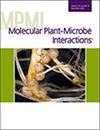求助PDF
{"title":"Early Activation of RNAi Reveals Genomic Regions of Grapevine Red Blotch Virus Targeted for Silencing in Grapevine.","authors":"Christian Mandelli, Laurent G Deluc","doi":"10.1094/MPMI-04-25-0038-R","DOIUrl":null,"url":null,"abstract":"<p><p>Grapevine red blotch virus (GRBV), a member of the <i>Geminiviridae</i> family that causes reduced fruit quality and yield, is an emerging challenge for the wine industry. Viticultural practices and pest management have been largely ineffective at mitigating the impacts of GRBV, necessitating alternative control strategies. Here, we investigated the early activation of RNA interference (RNAi) in GRBV-infected grapevines and, through small RNA sequencing, identified nine genomic virus-derived small-interfering RNA (vsiRNA)-producing regions referred to as hotspots (HSs). Subsequent analyses revealed that these HSs were primarily involved in producing 24-nt vsiRNA species associated with transcriptional gene silencing toward later stages of infection. Double-stranded RNA molecules derived from these HSs were administered to GRBV-infected plants via root soaking, significantly (<i>P</i> < 0.05) reducing viral gene expression in leaves and petioles for up to 1 month. Ultimately, we assessed the potential of viral mutation within these HSs, identified areas of higher mutational entropy, and found that most HS locations are within viral regions with lower probabilities of mutation events. These findings provide the basis for future research to characterize the role of small RNA-induced silencing mechanisms in grapevine-GRBV interactions and their potential translation for field-based technology, such as RNAi biopesticides, to manage red blotch disease. [Formula: see text] Copyright © 2025 The Author(s). This is an open access article distributed under the CC BY-NC-ND 4.0 International license.</p>","PeriodicalId":19009,"journal":{"name":"Molecular Plant-microbe Interactions","volume":" ","pages":"MPMI04250038R"},"PeriodicalIF":3.4000,"publicationDate":"2025-09-23","publicationTypes":"Journal Article","fieldsOfStudy":null,"isOpenAccess":false,"openAccessPdf":"","citationCount":"0","resultStr":null,"platform":"Semanticscholar","paperid":null,"PeriodicalName":"Molecular Plant-microbe Interactions","FirstCategoryId":"99","ListUrlMain":"https://doi.org/10.1094/MPMI-04-25-0038-R","RegionNum":3,"RegionCategory":"生物学","ArticlePicture":[],"TitleCN":null,"AbstractTextCN":null,"PMCID":null,"EPubDate":"","PubModel":"","JCR":"Q2","JCRName":"BIOCHEMISTRY & MOLECULAR BIOLOGY","Score":null,"Total":0}
引用次数: 0
引用
批量引用
Abstract
Grapevine red blotch virus (GRBV), a member of the Geminiviridae family that causes reduced fruit quality and yield, is an emerging challenge for the wine industry. Viticultural practices and pest management have been largely ineffective at mitigating the impacts of GRBV, necessitating alternative control strategies. Here, we investigated the early activation of RNA interference (RNAi) in GRBV-infected grapevines and, through small RNA sequencing, identified nine genomic virus-derived small-interfering RNA (vsiRNA)-producing regions referred to as hotspots (HSs). Subsequent analyses revealed that these HSs were primarily involved in producing 24-nt vsiRNA species associated with transcriptional gene silencing toward later stages of infection. Double-stranded RNA molecules derived from these HSs were administered to GRBV-infected plants via root soaking, significantly (P < 0.05) reducing viral gene expression in leaves and petioles for up to 1 month. Ultimately, we assessed the potential of viral mutation within these HSs, identified areas of higher mutational entropy, and found that most HS locations are within viral regions with lower probabilities of mutation events. These findings provide the basis for future research to characterize the role of small RNA-induced silencing mechanisms in grapevine-GRBV interactions and their potential translation for field-based technology, such as RNAi biopesticides, to manage red blotch disease. [Formula: see text] Copyright © 2025 The Author(s). This is an open access article distributed under the CC BY-NC-ND 4.0 International license.
早期激活的RNAi揭示了葡萄红斑病病毒沉默的目标基因组区域。
葡萄红斑病毒(GRBV)是双病毒科的一员,会导致果实质量和产量下降,是葡萄酒行业面临的一个新挑战。葡萄栽培方法和病虫害管理在很大程度上无法减轻GRBV的影响,因此需要采取其他控制战略。在这里,我们研究了grbv感染葡萄藤中RNA干扰(RNAi)的早期激活,并通过小RNA测序确定了9个基因组病毒衍生的小干扰RNA (vsiRNA)产生区域,称为热点(HS)。随后的分析显示,这些HS主要参与产生与感染后期转录基因沉默相关的24nt vsiRNA物种。从这些HS衍生的双链RNA (dsRNA)分子通过根浸泡处理grbv感染的植物,在长达一个月的时间里显著(p < 0.05)降低了叶片和叶柄中的病毒基因表达。最后,我们评估了这些HS内病毒突变的潜力,确定了突变熵较高的区域,并发现大多数HS位置位于突变事件概率较低的病毒区域内。这些发现为进一步研究小RNA (sRNA)诱导的沉默机制在葡萄藤- grbv相互作用中的作用及其在RNAi生物农药等田间技术管理红斑病方面的潜在翻译提供了基础。
本文章由计算机程序翻译,如有差异,请以英文原文为准。

 求助内容:
求助内容: 应助结果提醒方式:
应助结果提醒方式:


